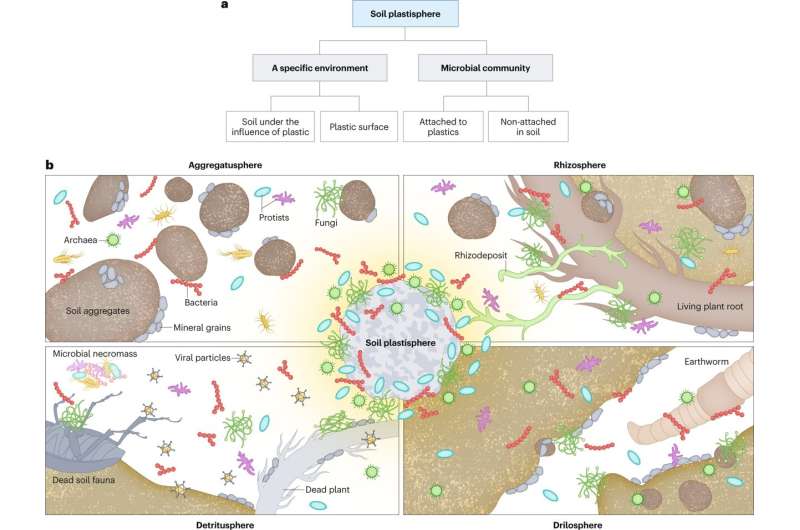This article has been reviewed according to Science X's editorial process and policies. Editors have highlighted the following attributes while ensuring the content's credibility:
fact-checked
peer-reviewed publication
trusted source
proofread
The soil plastisphere: Effects of microplastic particles in soil

Plastic is everywhere in the environment, and while earlier research efforts have dealt predominantly with the ocean and aquatic systems, soil has increasingly come into focus, especially soils in agricultural ecosystems, where we grow our food.
Professor Matthias C. Rillig (Institute of Biology at Freie Universität Berlin), together with co-authors Dr. Shin Woong Kim (a postdoctoral researcher in Rillig's lab) and Professor Yong-Guan Zhu (China), have now introduced a consolidated concept of the soil plastisphere, in reference to the soil under the immediate influence of plastic particles.
Their study, published in Nature Reviews Microbiology, summarizes several years of research work on the microbial community (or "microbiome") that colonizes plastic particles. The plastisphere is of key significance in understanding the effects of plastic on terrestrial ecosystems.
When thinking about humanity's impact on the planet, most people think of climate change first. But humans also affect their environment through pollution. One pollutant that has recently gained attention is plastic, more precisely microplastic, that is, particles that are smaller than 5 mm in diameter. These microplastic particles are found virtually anywhere.
Given that they are a much more obvious feature in the ocean and other aquatic ecosystems, researchers examined these areas first. But recently there has been a concerted effort to understand the effects of plastic pollution in terrestrial ecosystems, and in particular the soil.
Plastic is a rather unique form of pollution, since it consists of particles; that is, items with an internal volume and a surface. This makes them quite different from other chemical pollutants, which generally are not particles. The nature of particles opens up completely new research questions, and among them is what happens with these particles in natural ecosystems, and how does soil life, in particular microbial life, interact with these novel surfaces.
Rillig addresses the microbiology of plastic particles themselves in his recent paper in Nature Reviews Microbiology. Rillig and co-authors first clarified the definition of the soil "plastisphere" as the soil under the immediate influence of plastic particles; this includes the soil itself as well as the microbial community in this soil and on the plastic surface.
"There have been rather conflicting definitions of this term. This kind of conflict is, of course, not atypical of situations in new research fields. It was necessary to first bring clarity to what the concept of plastisphere really should represent," explains Rillig.
"Virtually all work so far had examined the microbial community colonizing the plastic surface," Rillig says. Therefore, the next challenge for researchers will be to find out just how far the plastisphere effect radiates into the soil. The plastisphere effect involves various factors, but the most important one is likely the chemical compounds that leach out of the interior of the plastic particle into the soil (the so-called "additives" that give plastics their desired properties, such as color or flexibility).
"The greatest challenge for the future is to understand how the microbial community assembles on the plastic surface and in the plastisphere," emphasizes Rillig. "This is not really understood yet."
Previous research that Rillig also contributed to had shown that the microbial community on plastic surfaces in soil can show higher levels of antibiotic resistance genes and putative pathogens. It is not yet clear why this occurs. One likely explanation is that the plastic surface is a rather stressful environment for some of the organisms.
There is no question that the microbial community on the particles is very different from the microbiome in the rest of the soil. For one thing, it is much less diverse; this is simply because the physical and chemical conditions of the habitat are drastically different near or on these plastic particles when compared with the rest of the soil.
Another clear feature of the plastisphere microbial community is that it is rich in microbes—bacteria and fungi—that can potentially degrade plastic. Some of these organisms may hold the key to remediation efforts. But Rillig cautions, "I am pessimistic that this will work because plastic is not just one thing. It is literally thousands of different things: a contaminant suite." Therefore, it is unlikely that a remediation method would work, generally speaking.
The plastisphere is a new environmental compartment in soils everywhere, particularly in agricultural soils. Moreover, it is probably here to stay. Hence, further research is needed on what shapes the microbes colonizing this compartment, and what the functions of these microbes are. Such knowledge would help determine the effects on soil functions. According to Rillig, "The long-term consequences are still almost completely unknown, and this can still hold many surprises."
More information: Matthias C. Rillig et al, The soil plastisphere, Nature Reviews Microbiology (2023). DOI: 10.1038/s41579-023-00967-2
Journal information: Nature Reviews Microbiology
Provided by Free University of Berlin


















